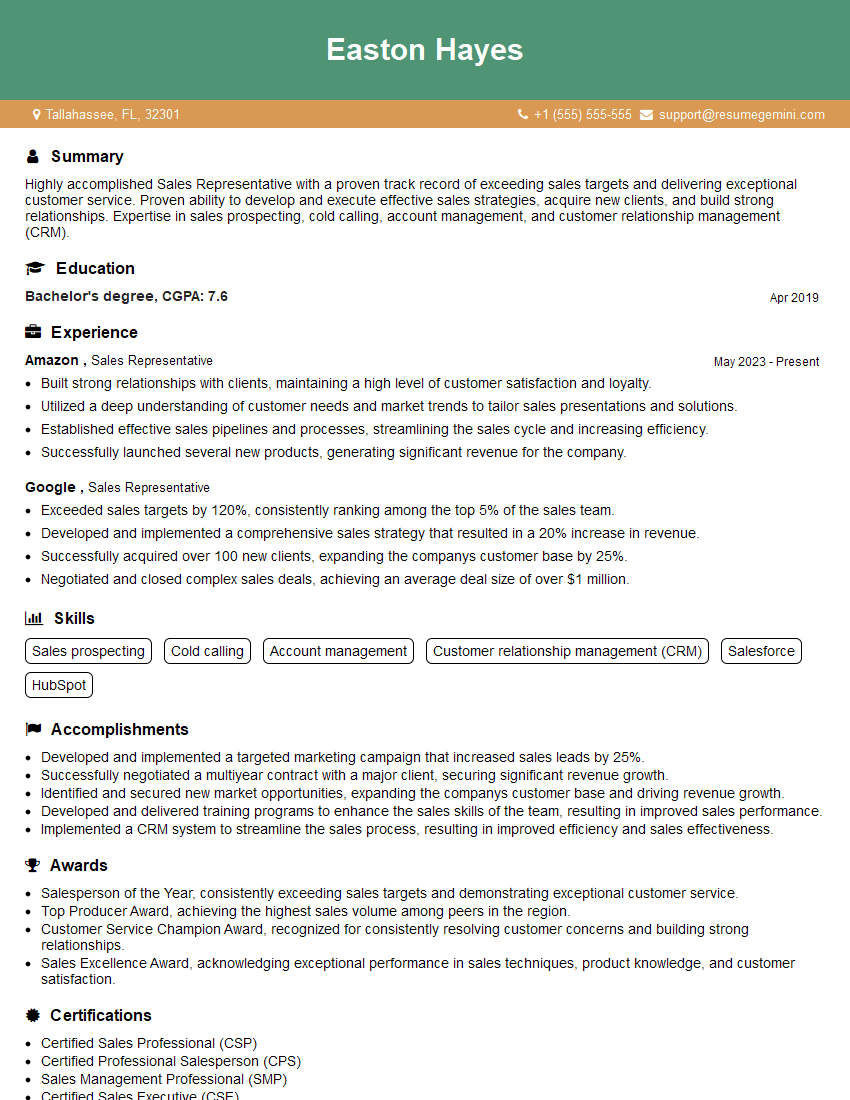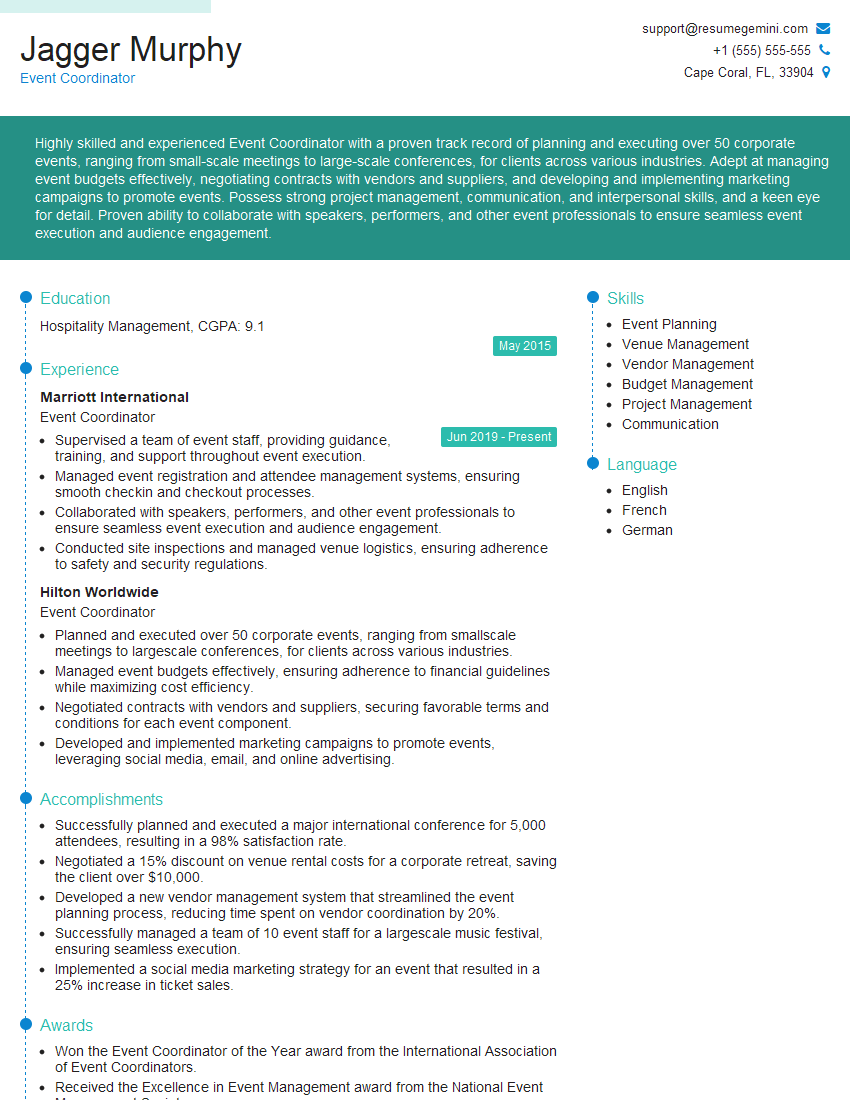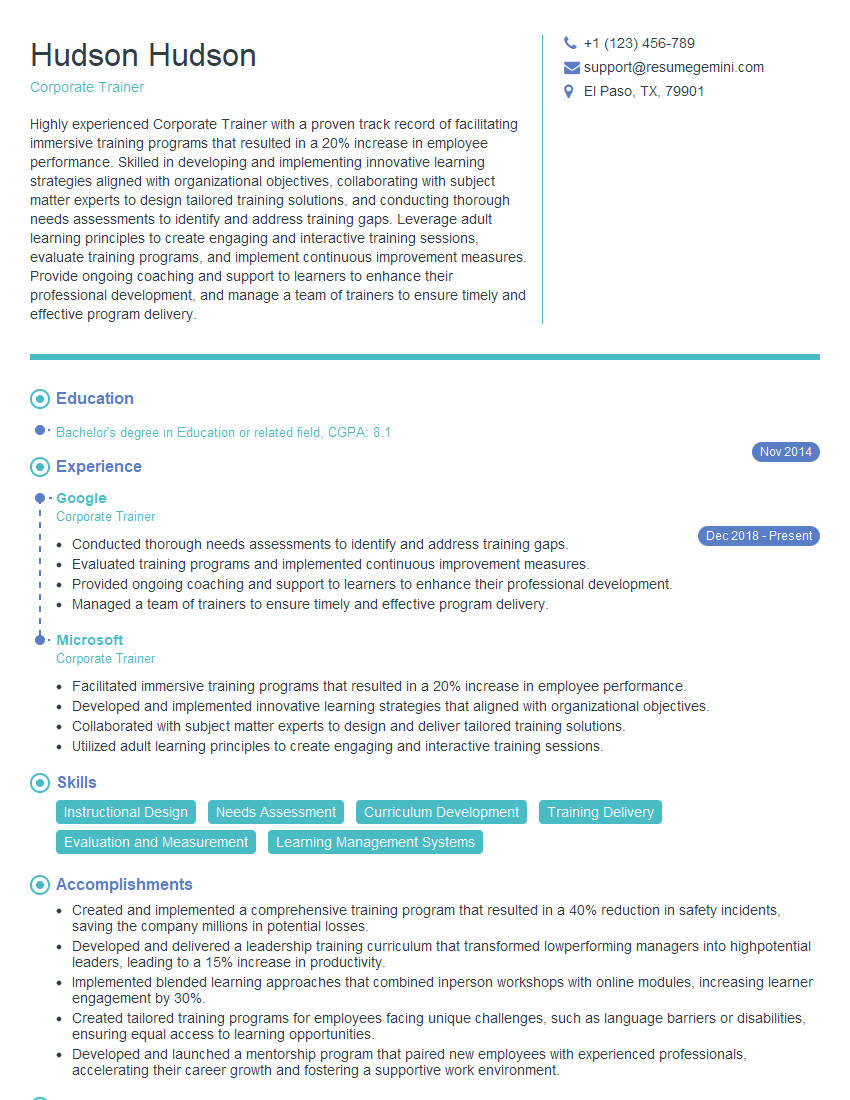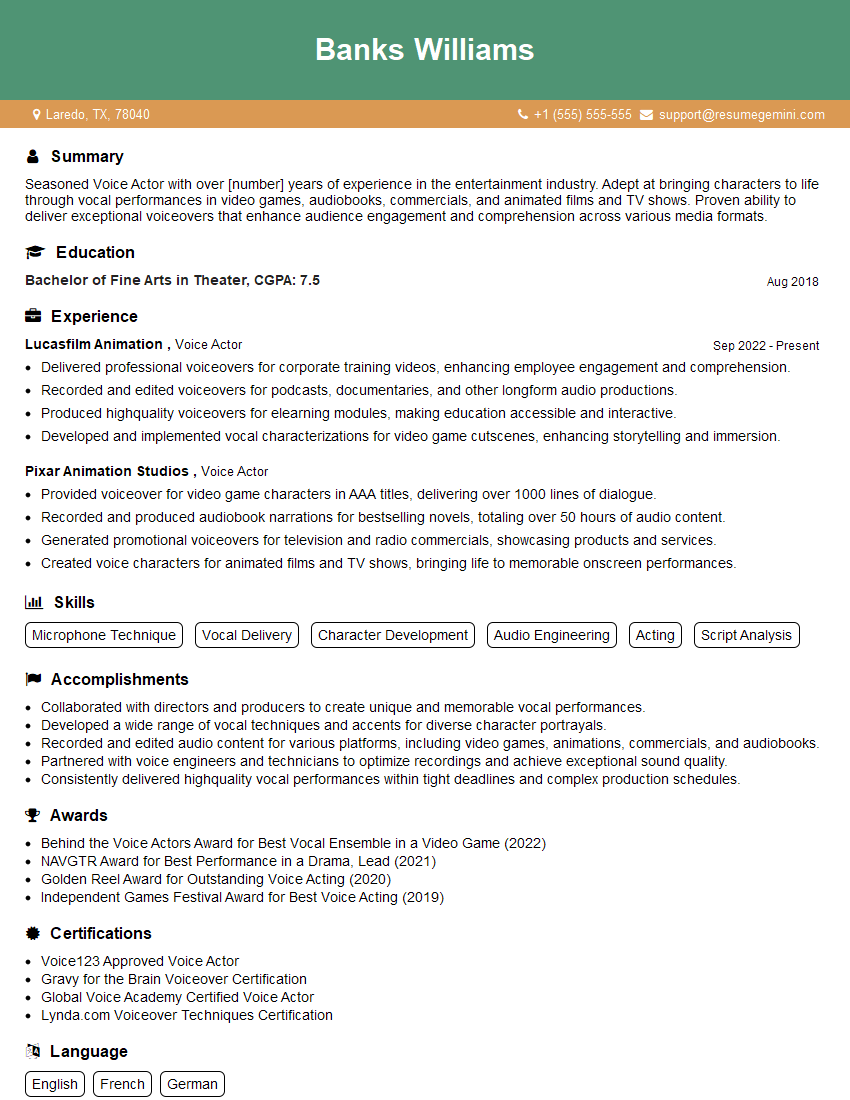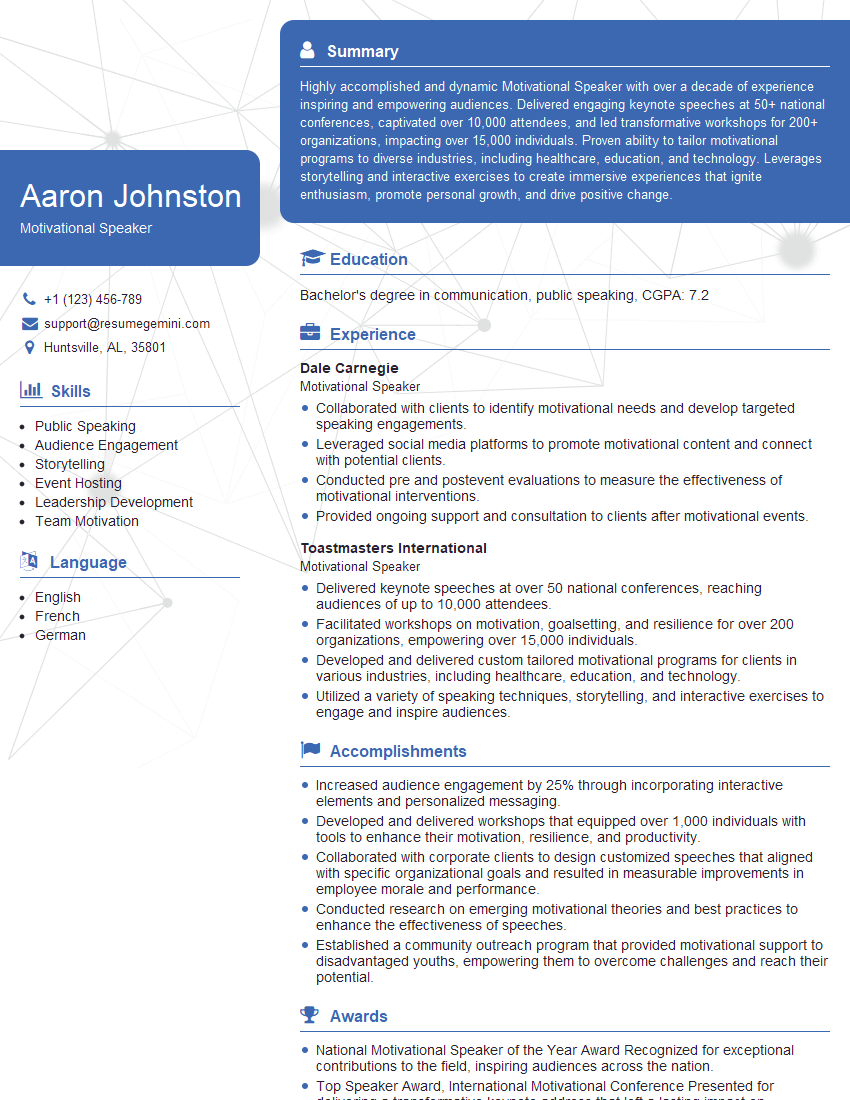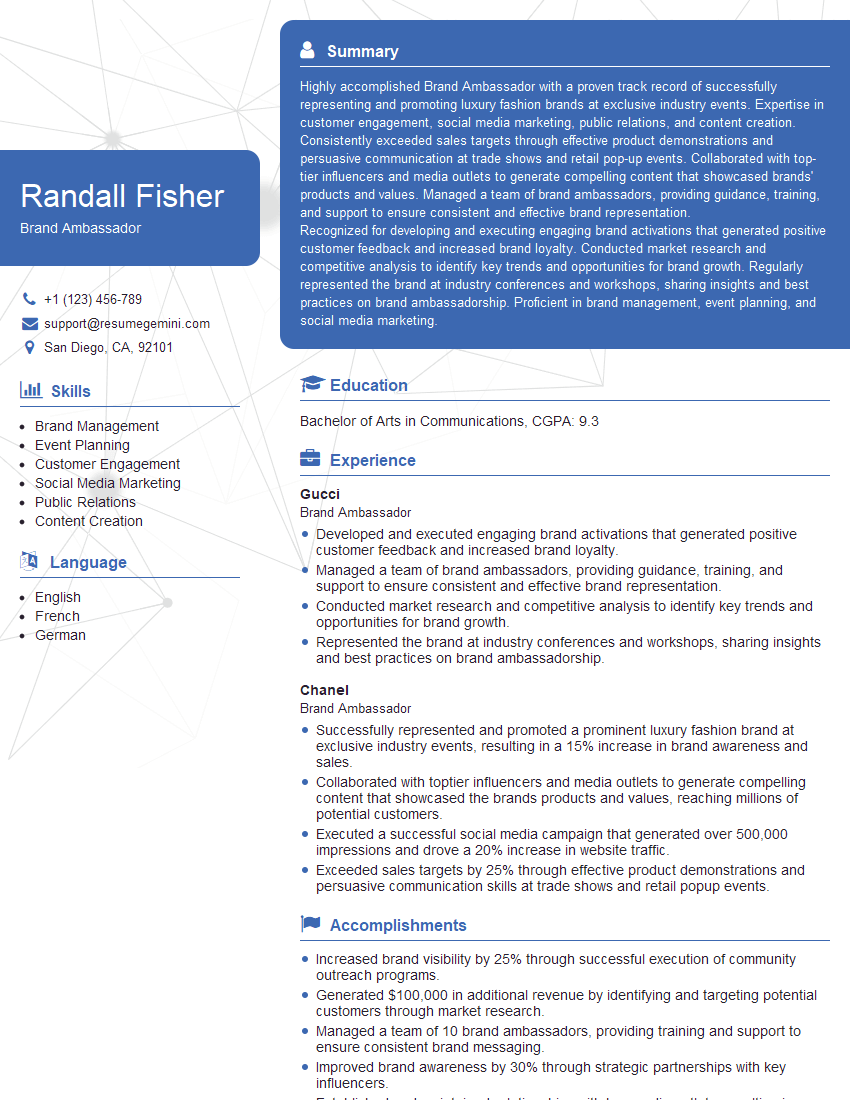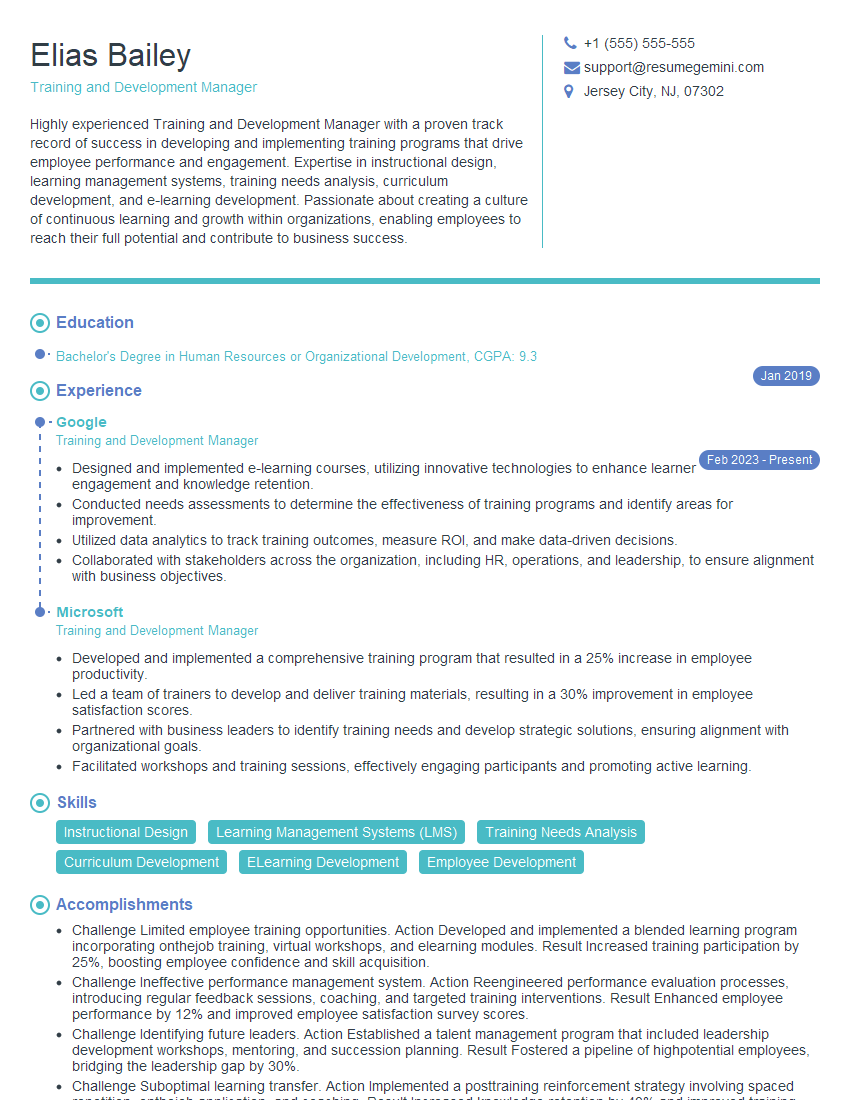Are you ready to stand out in your next interview? Understanding and preparing for Exceptional Stage Presence and Performance Skills interview questions is a game-changer. In this blog, we’ve compiled key questions and expert advice to help you showcase your skills with confidence and precision. Let’s get started on your journey to acing the interview.
Questions Asked in Exceptional Stage Presence and Performance Skills Interview
Q 1. Describe your approach to managing stage fright.
Stage fright is a common experience, but it’s entirely manageable. My approach is multifaceted, focusing on preparation, mindfulness, and positive self-talk. Preparation involves thorough rehearsal, not just memorizing the content, but also practicing the delivery, including body language and transitions. This reduces uncertainty and boosts confidence. Mindfulness techniques like deep breathing exercises before a presentation help calm the nervous system. Finally, I utilize positive self-talk, replacing negative thoughts like ‘I’m going to mess this up’ with affirmations such as ‘I’m prepared and capable’. I visualize a successful presentation, focusing on positive outcomes. This combination of preparation, mindfulness, and positive reinforcement creates a strong foundation for overcoming stage fright.
Q 2. How do you adapt your presentation style to different audiences?
Adapting to different audiences requires careful consideration of their background, knowledge level, and interests. For example, a technical presentation to a group of engineers will demand a different approach than a presentation to a group of lay people. With engineers, I can utilize technical jargon and delve into specifics. However, for a lay audience, I would simplify complex concepts, using analogies and real-world examples to make the information accessible and engaging. I also adjust my communication style. A formal audience may require a more structured and formal presentation, whereas a less formal group might respond better to a more conversational and interactive approach. Pre-presentation audience research, including reviewing relevant publications or talking to individuals within the group, is crucial for tailoring my presentation effectively.
Q 3. Explain your process for crafting a compelling narrative.
Crafting a compelling narrative involves structuring the presentation around a clear and engaging storyline. I begin by identifying a central theme or message. Then, I develop this theme using a clear beginning, middle, and end structure. The beginning should grab the audience’s attention – I might use a captivating anecdote, a surprising statistic, or a thought-provoking question. The middle develops the narrative, providing evidence and supporting arguments to substantiate the central theme, using examples, stories, and data to illustrate key points. The end should provide a satisfying conclusion, summarizing key takeaways and leaving a lasting impression. I also focus on creating relatable characters and situations within the narrative, helping the audience connect emotionally with the message. Think of it like a well-written short story, but with the added purpose of delivering valuable information.
Q 4. How do you use nonverbal communication to enhance your message?
Nonverbal communication plays a crucial role in enhancing a message. My approach focuses on utilizing eye contact to connect with individual audience members, creating a sense of intimacy and trust. I use purposeful gestures to emphasize key points, and maintain an open and approachable posture to appear confident and relatable. My facial expressions reflect the tone and emotion of my message, ensuring congruence between verbal and nonverbal cues. Varying vocal tone and pace keeps the audience engaged and prevents monotony. I also utilize pauses strategically for emphasis and to allow the audience to process information. The combination of these nonverbal cues significantly enhances the impact and memorability of my message.
Q 5. Describe a time you had to improvise during a presentation.
During a presentation on sustainable business practices, a question arose regarding a specific government regulation that I hadn’t anticipated. Instead of admitting ignorance, I acknowledged the complexity of the regulation, then used my knowledge of related policies to offer a reasoned, albeit somewhat speculative, answer. I reframed the question, directing it towards the larger principles of sustainable practices, highlighting the importance of adapting to evolving regulations. I then transitioned smoothly back to my prepared material, emphasizing that the core message – the benefits of sustainable practices – remained unaffected by the complexities of specific regulations. This improvisation showcased my adaptability and problem-solving skills, maintaining audience engagement despite an unexpected challenge.
Q 6. How do you handle Q&A sessions effectively?
Effective Q&A sessions require active listening, thoughtful responses, and skillful management. I begin by clearly stating the rules for the Q&A session, specifying the time allotted and the format. When answering questions, I listen carefully, repeating or paraphrasing the question to ensure understanding and to buy time to formulate a response. I answer concisely and directly, avoiding jargon, and use clear and simple language. If I don’t know the answer, I openly admit it, promising to follow up later or directing the question to someone who might know. I maintain a calm and respectful demeanor, even when faced with challenging or critical questions. Concluding the Q&A with a summary of key insights reinforces learning and leaves a lasting impression.
Q 7. What strategies do you use to maintain audience engagement?
Maintaining audience engagement requires a proactive approach. I incorporate interactive elements such as polls, quizzes, or brief group discussions to actively involve the audience. I use storytelling and humor to connect with the audience on an emotional level. I vary my delivery, incorporating visuals, audio, and even movement to keep things dynamic. Regularly checking for understanding through questions or observations ensures the audience is following along. I also encourage questions throughout the presentation, fostering a sense of two-way communication. By creating a dynamic and interactive experience, I ensure the audience remains engaged and actively participates in the learning process.
Q 8. How do you incorporate visual aids to improve your presentations?
Visual aids are crucial for enhancing engagement and clarity in presentations. They shouldn’t be mere decorations, but rather strategic tools to support and amplify your message. My approach involves carefully selecting the right type of visual for the specific content. For instance, a complex statistical comparison benefits from a well-designed chart or graph, while a narrative might be better served by compelling imagery.
I avoid clutter and ensure visuals are high-quality, easily readable, and consistent in style. I also rehearse with my visuals beforehand to ensure a smooth and seamless presentation. For example, in a presentation on market trends, I’d use an interactive graph to showcase data dynamically, rather than just static numbers. This allows for a more engaging and memorable experience for the audience.
In choosing visual aids, I follow a few key principles: Keep it simple (KISS principle), use high-resolution images, and make sure the visuals are relevant to the point being made. Poorly designed or irrelevant visuals can distract and detract from your presentation.
Q 9. How do you ensure your message is clear and concise?
Clarity and conciseness are paramount for effective communication. My strategy begins with a clear understanding of my central message. I then carefully craft my points, ensuring each one directly supports the overall theme. I avoid jargon and technical terms unless my audience is exceptionally familiar with them, and if used, I always clearly define them.
I structure my presentations logically, employing storytelling techniques to make complex information more easily digestible. For example, I might start with a compelling anecdote, build the narrative around supporting data, and conclude with a clear call to action. I also practice delivering the presentation aloud multiple times, refining the language and pacing to ensure effortless flow and impact. This iterative process eliminates unnecessary words and streamlines the message for optimal clarity.
Q 10. Describe your experience with public speaking technologies.
My experience with public speaking technologies is extensive. I’m proficient with various presentation software, including PowerPoint, Keynote, and Google Slides. I’m comfortable integrating multimedia elements like videos and audio clips to enhance presentations. Furthermore, I have experience using presentation-enhancing technologies like teleprompters for maintaining consistent delivery, and webinar platforms like Zoom or WebEx for virtual presentations.
Beyond software proficiency, I possess a strong understanding of audio-visual equipment setup and troubleshooting. This includes microphone usage, projector operation, and screen sharing capabilities. I’m adept at adapting to different technological setups and ensuring the technology complements, not hinders, my presentation.
Q 11. How do you prepare for a high-pressure presentation?
Preparing for high-pressure presentations requires a structured and thorough approach. My strategy involves detailed planning, rehearsal, and mental preparation. I start by thoroughly researching my topic, anticipating potential questions, and creating robust backup plans for unforeseen technical difficulties. This reduces the potential for anxiety-inducing surprises.
I then rehearse the presentation multiple times, ideally in front of a test audience, to identify areas for improvement and refine my delivery. This helps build confidence and familiarity with the material. Finally, I engage in techniques to manage performance anxiety, such as deep breathing exercises and visualization. The goal is to transform nerves into focused energy, turning the pressure into a positive driving force.
Q 12. What are your strengths and weaknesses as a presenter?
My strengths as a presenter include strong communication skills, the ability to connect with audiences on an emotional level, and the confidence to command attention. I excel at tailoring my presentations to the specific audience and context. I can effectively use humor and storytelling to make complex topics accessible.
One area I’m continually working on is improving my ability to handle unexpected interruptions or challenging questions with even greater composure and grace. While I’m generally adept at managing difficult situations, I strive to consistently improve my ability to navigate unexpected scenarios with calm professionalism. This continuous self-improvement is key to maintaining a high level of performance.
Q 13. How do you use storytelling to connect with your audience?
Storytelling is an incredibly powerful tool for connecting with audiences. It allows me to convey complex information in a memorable and engaging way, making my message more relatable and impactful. I typically embed narratives within my presentations, using anecdotes, case studies, or personal experiences to illustrate key points.
For instance, in a presentation on leadership, I might share a personal story about a time I faced a challenging leadership situation and how I overcame it. This personal touch makes the information more relatable and strengthens the audience’s connection with my message. The key is to choose stories that are relevant, concise, and emotionally resonant.
Q 14. Explain your understanding of audience analysis.
Audience analysis is fundamental to crafting an effective presentation. Before any presentation, I conduct thorough research to understand the audience’s demographics, knowledge level, expectations, and interests. This information helps me tailor my message, language, and visual aids to resonate with them.
For example, a presentation to a group of technical experts would differ significantly from one delivered to a general audience. In the first case, technical jargon might be appropriate and expected. However, for a general audience, I’d simplify the language and focus on easily grasped concepts. Understanding the audience’s needs and expectations is key to maximizing engagement and achieving my presentation goals.
Q 15. How do you manage your energy levels during long presentations?
Maintaining energy during long presentations is crucial for sustained audience engagement. It’s not just about physical stamina; it’s about managing mental and emotional energy too. My approach is multifaceted:
Pre-Presentation Preparation: I prioritize sufficient sleep, hydration, and a nutritious meal beforehand. Think of it like fueling a car for a long journey.
Strategic Breaks: For presentations exceeding an hour, I incorporate planned pauses. These aren’t just for the audience; they’re vital for me to reset. A quick sip of water, a deep breath, or a brief moment to refocus my mind makes a huge difference.
Engaging Delivery: I vary my vocal tone, pace, and body language to prevent monotony. Think of it like a musical piece – there are crescendos and diminuendos, quiet moments and powerful declarations. This keeps both me and the audience stimulated.
Mindfulness Techniques: I utilize short mindfulness exercises before and during breaks. Even a few seconds of deep, focused breathing can significantly improve concentration and reduce stress.
Audience Interaction: Engaging the audience through questions, polls, or small group activities breaks the monotony and reinvigorates both them and me. It transforms the presentation from a one-way lecture into a collaborative experience.
For example, during a recent three-hour workshop, I incorporated a 10-minute interactive exercise halfway through. This not only re-energized the participants but also allowed me to recharge and maintain a high level of enthusiasm for the remaining session.
Career Expert Tips:
- Ace those interviews! Prepare effectively by reviewing the Top 50 Most Common Interview Questions on ResumeGemini.
- Navigate your job search with confidence! Explore a wide range of Career Tips on ResumeGemini. Learn about common challenges and recommendations to overcome them.
- Craft the perfect resume! Master the Art of Resume Writing with ResumeGemini’s guide. Showcase your unique qualifications and achievements effectively.
- Don’t miss out on holiday savings! Build your dream resume with ResumeGemini’s ATS optimized templates.
Q 16. Describe your experience using different presentation formats.
My experience spans diverse presentation formats, each requiring a unique approach:
Keynote Speeches: These often involve a grander scale, focusing on a compelling narrative and strong visuals to captivate a large audience. For example, I once delivered a keynote on leadership at a national conference, emphasizing impactful storytelling and using high-quality visuals to enhance the message.
Workshops: These are highly interactive, requiring active participation and often smaller group sizes. The focus shifts towards practical application and skill-building. I’ve led numerous workshops on communication skills, incorporating hands-on exercises and group discussions.
Webinars: The virtual environment demands a different approach, focusing on clear audio-visual quality and engaging online interaction. I’ve found that using polls and Q&A sections helps to maintain audience participation and prevent digital fatigue.
Training Sessions: These require a structured and methodical approach, focusing on knowledge transfer and skill development. Often, these involve detailed slide decks and practical examples.
My adaptability ensures that I tailor my style and content to match the format, maximizing impact and engagement in each scenario.
Q 17. How do you handle difficult or challenging questions?
Handling difficult questions requires a combination of composure, empathy, and strategic thinking. My approach involves:
Active Listening: I carefully listen to the question, ensuring I fully understand the underlying concern before responding. This shows respect and prevents misinterpretations.
Acknowledge and Validate: I acknowledge the validity of the question, even if I disagree with the premise. Phrases like, “That’s a great question,” or “I understand your concern,” can go a long way in diffusing tension.
Structure My Response: I structure my response clearly and concisely, addressing each part of the question directly. If I don’t know the answer, I admit it honestly and offer to find out the information.
Maintain Positivity: Even when faced with challenging or confrontational questions, I maintain a positive and respectful demeanor. This helps to set a calm and productive tone.
For instance, during a Q&A session, I was once asked a question that challenged a key point in my presentation. Instead of getting defensive, I acknowledged the valid point in the question, then explained the nuance of my original point and how it addressed the concern. This approach led to a constructive dialogue and a deeper understanding amongst the audience.
Q 18. How do you maintain composure under pressure?
Maintaining composure under pressure is a skill honed over years of practice. It’s about managing both internal and external pressures. My strategies include:
Preparation: Thorough preparation is the cornerstone of confidence. The more prepared I am, the less likely I am to be flustered by unexpected events.
Deep Breathing: Deep, controlled breathing helps regulate my heart rate and calm my nerves. I often use this technique before and during challenging moments.
Positive Self-Talk: I employ positive affirmations to counteract negative thoughts and anxieties. This helps shift my focus from potential failures to my strengths and preparedness.
Visualization: I visualize a successful presentation, anticipating potential challenges and visualizing positive outcomes. This helps to build mental resilience.
Acceptance of Imperfection: I recognize that some things are beyond my control. Accepting this fact helps me to focus my energy on what I *can* control: my response and attitude.
For example, during a live presentation, the projector suddenly malfunctioned. Instead of panicking, I took a deep breath, switched to a backup plan (using a whiteboard), and calmly continued the presentation, using humor to connect with the audience about the unexpected turn of events.
Q 19. What is your preferred method for receiving constructive criticism?
My preferred method for receiving constructive criticism is open, direct, and respectful. I believe that feedback is an invaluable tool for growth. I approach it with:
Active Listening: I listen carefully and attentively, asking clarifying questions when necessary to ensure I fully understand the feedback.
Appreciation: I express gratitude for the time and effort the person has taken to provide feedback. This demonstrates respect and encourages future constructive input.
Reflection: I take time to reflect on the feedback, considering its validity and applicability to my future presentations. I don’t necessarily agree with every point, but I always consider the perspective.
Actionable Steps: I identify specific and actionable steps I can take to improve based on the feedback. This transforms criticism into a plan for growth.
I always seek feedback from diverse sources, ensuring I receive a range of perspectives, and I’m proactive in asking for feedback, rather than waiting for it to be given.
Q 20. How do you handle technical difficulties during a presentation?
Handling technical difficulties requires preparedness and adaptability. My approach is based on:
Pre-Presentation Checks: I always conduct thorough technical checks well before the presentation, ensuring all equipment is functioning correctly and backups are in place.
Backup Plans: I have contingency plans for common technical issues, such as projector malfunctions or internet connectivity problems. This could involve printed handouts, alternative presentation formats, or a simplified version of my presentation.
Calm and Professional Demeanor: If a technical problem arises during the presentation, I maintain a calm and professional demeanor, addressing the issue directly and honestly with the audience.
Audience Engagement: I use the unexpected delay as an opportunity to engage the audience, perhaps sharing a relevant anecdote or prompting a brief discussion.
Technical Support: I have pre-arranged support from a technical person, if the event warrants it.
Once, during a crucial presentation, the internet connection failed. Having anticipated this possibility, I immediately switched to a pre-prepared offline version of my presentation. I addressed the issue transparently with the audience, explaining the situation and assuring them that the transition wouldn’t disrupt the core message. The presentation continued smoothly, demonstrating my ability to handle unexpected events professionally.
Q 21. Describe your process for practicing a presentation.
My presentation practice is a structured process designed to maximize impact and ensure a polished performance:
Content Mastery: I start by thoroughly understanding the content, ensuring I can explain it clearly and concisely.
Structure and Flow: I carefully structure the presentation with a clear beginning, middle, and end, ensuring a logical flow of information.
Rehearsals: I rehearse the presentation multiple times, refining my delivery and identifying areas for improvement. This process usually involves a combination of speaking aloud and practicing with visuals.
Visual Aids: I ensure the visual aids, such as slides or props, are well-designed, relevant, and enhance the presentation, not distract from it.
Feedback and Refinement: I seek feedback from trusted colleagues or mentors, using their suggestions to refine my delivery and content.
Mock Presentations: I conduct mock presentations to simulate the actual presentation environment. This helps to identify and address any unexpected challenges.
This systematic approach ensures I’m not only confident in the content but also polished in my delivery, resulting in a compelling and engaging experience for the audience.
Q 22. How do you incorporate humor effectively into your presentations?
Humor is a powerful tool for engagement, but it must be used judiciously. The key is to ensure the humor is relevant to the audience and the topic, never at the expense of professionalism. Avoid anything offensive or potentially divisive. My approach involves subtly weaving in anecdotes, observational humor, or self-deprecating jokes that relate to the subject matter. For instance, if I’m presenting on project management, I might share a lighthearted story about a past project challenge, highlighting the lessons learned in a humorous way. This approach makes the presentation more memorable and relatable, humanizing the information.
I carefully assess my audience beforehand to gauge their sense of humor. What might work for a tech-savvy group might fall flat with a more conservative audience. Timing is also critical; a well-placed joke can break the ice or highlight a key point, while a poorly timed one can derail the presentation entirely.
Q 23. How do you build rapport with your audience quickly?
Building rapport starts even before the presentation begins. I make a point of arriving early to engage with attendees informally, acknowledging their presence and initiating brief conversations. This shows genuine interest and makes them feel valued. During the presentation itself, I employ several techniques. I start by acknowledging the shared experience or challenge we’re addressing—this instantly creates a sense of community. I use inclusive language, making eye contact with individuals throughout the audience and referencing their contributions or perspectives. I also encourage interaction, either through questions, polls, or brief group activities, facilitating a sense of two-way communication rather than a one-way lecture.
For example, I might begin by saying something like, “I know many of you are facing the same challenges with X, and I’m excited to share strategies that have helped me and others overcome it.” This establishes a common ground and makes the audience receptive to my message.
Q 24. How do you measure the success of your presentations?
Success isn’t solely about audience applause; it’s a multi-faceted evaluation. I measure success through a combination of factors. Firstly, I gather quantitative data – post-presentation surveys gauging audience understanding, satisfaction levels, and actionable insights gained. This provides concrete feedback on the clarity and effectiveness of my message. Secondly, I analyze qualitative data. This includes direct feedback from attendees, observing their engagement during the presentation (e.g., active listening, participation), and monitoring post-presentation actions, such as increased engagement with related resources or the implementation of suggested strategies. Finally, I reflect on my own performance, identifying areas for improvement in delivery, content, and audience interaction.
For instance, a high satisfaction score coupled with evidence of attendees applying the presented knowledge in their work reflects significant success. Conversely, low scores or a lack of post-presentation engagement indicate areas needing refinement.
Q 25. Describe your experience using microphones and other audio-visual equipment.
I’m highly proficient in using various audio-visual equipment, including a range of microphones (lavalier, headset, handheld) and presentation software. My experience includes setting up and testing equipment prior to presentations, adjusting microphone levels to ensure optimal sound quality, and troubleshooting technical issues during live presentations. I am comfortable with various presentation technologies, including projectors, screens, interactive whiteboards, and online conferencing platforms like Zoom or Teams. This expertise allows me to maintain a seamless and professional presentation flow, even in unpredictable technical environments.
In one instance, during a large-scale conference, the primary projector malfunctioned just moments before my presentation. Quickly, I switched to a backup projector and seamlessly adapted to the change, ensuring the presentation continued without interruption. This experience highlighted the importance of preparedness and adaptability.
Q 26. What strategies do you use to overcome nervousness before a presentation?
Overcoming nervousness is a crucial skill. My strategy involves a combination of preparation and mindful techniques. Thorough preparation is key; the more familiar I am with the material, the less anxious I feel. I practice the presentation multiple times, refining my delivery and anticipating potential questions. Beyond preparation, I use mindfulness techniques like deep breathing exercises and visualization to calm my nerves before taking the stage. I visualize a successful presentation, focusing on positive outcomes and confident delivery. I also engage in physical activity beforehand to release tension and boost my energy levels.
Instead of viewing nervousness as a negative, I reframe it as excitement, recognizing that it indicates a level of engagement and investment in the presentation.
Q 27. How do you tailor your message to suit different communication channels?
Tailoring my message to different communication channels requires a nuanced understanding of each platform’s strengths and limitations. A presentation for a live audience differs greatly from a written report or a social media post. For live audiences, I prioritize engaging storytelling, visual aids, and interactive elements. Written reports demand clarity, conciseness, and strong supporting evidence. Social media necessitates brevity, compelling visuals, and a conversational tone. In all cases, I maintain a consistent core message while adapting the style and structure to suit the audience and the chosen channel.
For example, a complex technical concept might be explained with detailed diagrams and straightforward language in a written report, but simplified and visually represented with animations during a live presentation. On social media, a short, engaging video highlighting the key takeaway would be most effective.
Q 28. Describe your experience in a high-stakes presentation setting.
During a high-stakes presentation to a major client, I was responsible for pitching a new marketing strategy. The stakes were high – the success of the pitch could impact the direction of the company. To prepare, I rigorously researched the client’s needs and competitive landscape, preparing detailed data-driven arguments and addressing potential objections. During the presentation, I maintained a calm and confident demeanor, ensuring my message was clear, concise, and persuasive. I engaged the client in a constructive dialogue, skillfully answering their questions and addressing their concerns. The result was a successful pitch, securing a substantial contract for my company.
This experience underscored the significance of thorough preparation, confident delivery, and adaptability in high-pressure situations. The meticulous planning and thoughtful engagement with the client were crucial to achieving a favorable outcome.
Key Topics to Learn for Exceptional Stage Presence and Performance Skills Interview
- Commanding Vocal Delivery: Understanding vocal projection, tone modulation, and pacing to engage your audience effectively. Practical application: Practice delivering a short presentation, recording yourself, and analyzing your vocal delivery for improvement.
- Confident Body Language: Mastering posture, gestures, and eye contact to convey confidence and credibility. Practical application: Practice mindful body language in front of a mirror or with a friend, receiving constructive feedback.
- Engaging Storytelling: Structuring narratives to captivate your audience and illustrate your key points. Practical application: Develop a concise personal anecdote that demonstrates your skills and tailor it for different interview scenarios.
- Handling Q&A with Grace: Responding to challenging questions thoughtfully and articulately, maintaining composure and professionalism. Practical application: Anticipate potential questions and rehearse thoughtful, concise answers.
- Adapting to Different Audiences: Tailoring your communication style to suit various contexts and personalities. Practical application: Consider how you’d adjust your presentation for a technical vs. non-technical audience.
- Managing Nervousness: Implementing techniques to control anxiety and deliver a polished performance. Practical application: Explore relaxation techniques like deep breathing or mindfulness exercises before presentations.
- Understanding Nonverbal Communication: Recognizing and interpreting nonverbal cues from the interviewer(s) to enhance your interactions. Practical application: Practice active listening and observe nonverbal cues during mock interviews.
Next Steps
Mastering exceptional stage presence and performance skills is crucial for career advancement, opening doors to leadership roles and high-impact opportunities. A strong resume showcasing these skills is your first step towards securing those opportunities. Building an ATS-friendly resume is essential to get your application noticed by recruiters. We recommend using ResumeGemini, a trusted resource, to craft a compelling and effective resume that highlights your abilities. Examples of resumes tailored to Exceptional Stage Presence and Performance Skills are available to help you get started.
Explore more articles
Users Rating of Our Blogs
Share Your Experience
We value your feedback! Please rate our content and share your thoughts (optional).
What Readers Say About Our Blog
Hello,
We found issues with your domain’s email setup that may be sending your messages to spam or blocking them completely. InboxShield Mini shows you how to fix it in minutes — no tech skills required.
Scan your domain now for details: https://inboxshield-mini.com/
— Adam @ InboxShield Mini
Reply STOP to unsubscribe
Hi, are you owner of interviewgemini.com? What if I told you I could help you find extra time in your schedule, reconnect with leads you didn’t even realize you missed, and bring in more “I want to work with you” conversations, without increasing your ad spend or hiring a full-time employee?
All with a flexible, budget-friendly service that could easily pay for itself. Sounds good?
Would it be nice to jump on a quick 10-minute call so I can show you exactly how we make this work?
Best,
Hapei
Marketing Director
Hey, I know you’re the owner of interviewgemini.com. I’ll be quick.
Fundraising for your business is tough and time-consuming. We make it easier by guaranteeing two private investor meetings each month, for six months. No demos, no pitch events – just direct introductions to active investors matched to your startup.
If youR17;re raising, this could help you build real momentum. Want me to send more info?
Hi, I represent an SEO company that specialises in getting you AI citations and higher rankings on Google. I’d like to offer you a 100% free SEO audit for your website. Would you be interested?
Hi, I represent an SEO company that specialises in getting you AI citations and higher rankings on Google. I’d like to offer you a 100% free SEO audit for your website. Would you be interested?
good

